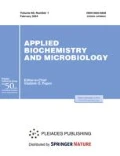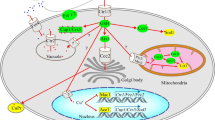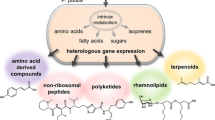Abstract
The activity of chorismate synthase, the terminal enzyme of the common aromatic pathway, is absolutely dependent on reduced flavin mononucleotide. The bifunctional chorismate synthase of Saccharomyces cerevisiae (product of the ARO2 gene) can reduce flavin in a reaction that involves NADPH, in contrast to the monofunctional chorismate synthase of Escherichia coli (product of the aro C gene). The latter enzyme does not have the capacity for flavin reduction, and its activity therefore depends on the flavin reductase function of the cell. Chemical synthesis of the structural part of the ARO2 gene that involved the substitution of rare E. coli codons was performed for an in vivo comparison of the two types of chorismate synthase. ARO2 expression was tested in the T7 system, and isogenic E. coli strains TG1Δ aro CPtac-ARO2 and TG1Δ aro CPtac- aro C were obtained. Comparative analysis of proteins from the cell extracts of these strains and in silico assessment of hybrid RBS efficiency showed that the level of AroC protein synthesis in TG1Δ aro CPtac- aro C was higher than the level of ARO2 synthesis in the TG1Δ aro CPtac-ARO2 cells. The introduction of Ptac-ARO2 and Ptac- aro C modifications led to complete recovery of the growth of the aromatic auxotroph TG1Δ aro C on minimal mineral medium supplemented with glucose and restored phenylalanine production in the E. coli strain DV1017Δ aro C, which lacked chorismate synthase activity. The similar positive effects of Ptac- aro C and Ptac-ARO2 on phenylalanine biosynthesis in the DV1017ΔtyrR strain, in which chorismate synthase played a “bottleneck” role, indicated the absence of a limiting effect of reduced flavin on monofunctional chorismate synthase overexpressed in E. coli cells.
Similar content being viewed by others
Abbreviations
- HPLC:
-
high-performance liquid chromatography
- IPTG:
-
isopropyl-β-D-1-thiogalactopyranoside
- OD:
-
optical density
- PAG:
-
polyacrylamide gel
- PCR:
-
polymerase chain reaction
- LB medium:
-
Luria-Bertani medium
- FMNH2 :
-
reduced form of flavin mononucleotide
- MALDI-TOF:
-
matrix-assisted laser desorption-ionization time-of-flight (mass spectrometry)
- NADH:
-
reduced form of nicotinamide dinucleotide
- NADPH:
-
reduced form of nicotinamide dinucleotide phosphate
- RBS:
-
ribosome binding sites
- SD sequence:
-
Shine-Dalgarno sequence
- SDS:
-
sodium dodecyl sulfate.
References
Hawkes, T.R. Coggins, J.R., et al., Chorismate synthase: pre-steady-state kinetics of phosphate release from 5-enolpyruvylshikimate 3-phosphate, Biochem. J., 1990, vol. 265, no. 3, pp. 899–902.
Balasubramanian, S., Abell, C., and Coggins, J.R., Observation of an isotope effect in the chorismate synthase reaction, J. Am. Chem. Soc., 1990, vol. 112, no. 1, pp. 8581–8583.
White, P.J., Millar, G., and Coggins, J.R., The overexpression, purification and complete amino acid sequence of chorismate synthase from Escherichia coli K12 and its comparison with the enzyme from Neurospora crassa, Biochem. J., 1988, vol. 251, no. 2, pp. 313–322.
Ely, F., Nunes, J., Schroeder, E., et al., The Mycobacterium tuberculosis Rv2540c DNA sequence encodes a bifunctional chorismate synthase, BMC Biochem., 2008, vol. 9, no. 13. doi 10.1186/1471-2091-9-13
Brenda Database. http://www.brenda-enzymes.org/
Macheroux, P., Schmid, J., Amrhein, N., and Schaller, A., A unique reaction in a common pathway: mechanism and function of chorismate synthase in the shikimate pathway, Planta, 1999, vol. 207, no. 3, pp. 325–334.
Morell, H., Clark, M.J., Knowles, P.F., and Sprinson, D.B., The enzymic synthesis of chorismic and prephenic acids from 3-enolpyruvylshikimic acid 5-phosphate, J. Biol. Chan, 1967, vol. 242, no. 2, pp. 82–90.
Green, M.R. and Sambrook, J., Molecular Cloning: Laboratory Manual, 4th ed., New York, USA: Cold Spring Harbor Laboratory Press, 2012.
Doroshenko, V.G., Shakulov, R.S., Kazakova, S.M., et al., Construction of an L-phenylalanine-producing tyrosine-prototrophic Escherichia coli strain using tyrA ssrA-like tagged alleles, Biotechnol. Lett., 2010, vol. 32, no. 8, pp. 1117–1121. doi 10.1007/s10529-010-0265-1
Minaeva, N.I., Gak, E.R., Zimenkov, D.V., et al., Dual in/out strategy for genes integration into bacterial chromosome: a novel approach to step-by-step construction of plasmid-less marker-less recombinant E. coli strains with predesigned genome structure, BMC Biotechnol., 2008, vol. 8, no. 63. doi 10.1186/1472-6750-8-63
Katashkina, Zh.L., Skorokhodova, A.Iu., Zimenkov, D.V., et al., Tuning of expression level of the genes of interest located in the bacterial chromosome, Mol. Biol.,,2005 vol. 39, no. 5, pp. 823–831.
Wilson, G.G., Young, K.K.Y., and Edlin, G.J., Highfrequency generalized transduction by bacteriophage T4, Nature, 1979, vol. 280, no. 5717, pp. 80–82. doi 10.1038/280080a0
Gurskii, Ia.G., Marimont, N.Iu., and Bibilashvili, R.Sh., The effect of intracellular concentrations of tRNA, corresponding to the rare arginine codons AGG and AGA, on the gene expression in Escherichia coli, Mol. Biol., 1992, vol. 26, no. 5, pp. 1080–1087.
Olins, P.O. and Rangwala, S.H., A novel sequence element derived from bacteriophage T7 mRNA acts as an enhancer of translation of the lacZ gene in Escherichia coli, J. Biol. Chem., 1989, vol. 264, no. 29, pp. 16973–16976.
Seo, S.W., Yang, J.S., Kim, I., et al., Predictive design of mRNA translation initiation region to control prokaryotic translation efficiency, Metab. Eng., 2013, vol. 15, pp. 67–74. doi 10.1016/j.ymben.2012.10.006
Pittard, J., Camakaris, H., and Yang, J., The TyrR regulon, Mol. Microbiol., 2005, vol. 55, no. 1, pp. 16–26. doi 10.1111/J.1365-2958.2004.04385.X
Sauer, U., Canonaco, F., and Heri, S., The soluble and membrane-bound transhydrogenases UdhA and PntAB have divergent functions in NADPH metabolism of Escherichia coli, J. Biol. Chem., 2004, vol. 279, no. 8, pp. 6613–6619. doi 10.1074/jbc.M311657200
Canonaco, F., Hess, T.A., Heri, S., et al., Metabolic flux response to phosphoglucose isomerase knock-out in Escherichia coli and impact of overexpression of the soluble transhydrogenase UdhA, FEMS Microbiol. Letts., 2001, vol. 204, no. 2, pp. 247–252.
Author information
Authors and Affiliations
Corresponding author
Additional information
Original Russian Text © A.E. Slesareva, L.G. Kuhn, V.G. Doroshenko, 2017, published in Biotekhnologiya, 2017, Vol. 33, No. 2, pp. 48–55.
Rights and permissions
About this article
Cite this article
Slesareva, A.E., Kuhn, L.G. & Doroshenko, V.G. Comparative Analysis of Mono- and Bifunctional Chorismate Synthases in Escherichia coli Cells Capable and Incapable of Phenylalanine Production. Appl Biochem Microbiol 53, 867–873 (2017). https://doi.org/10.1134/S0003683817090071
Received:
Accepted:
Published:
Issue Date:
DOI: https://doi.org/10.1134/S0003683817090071




